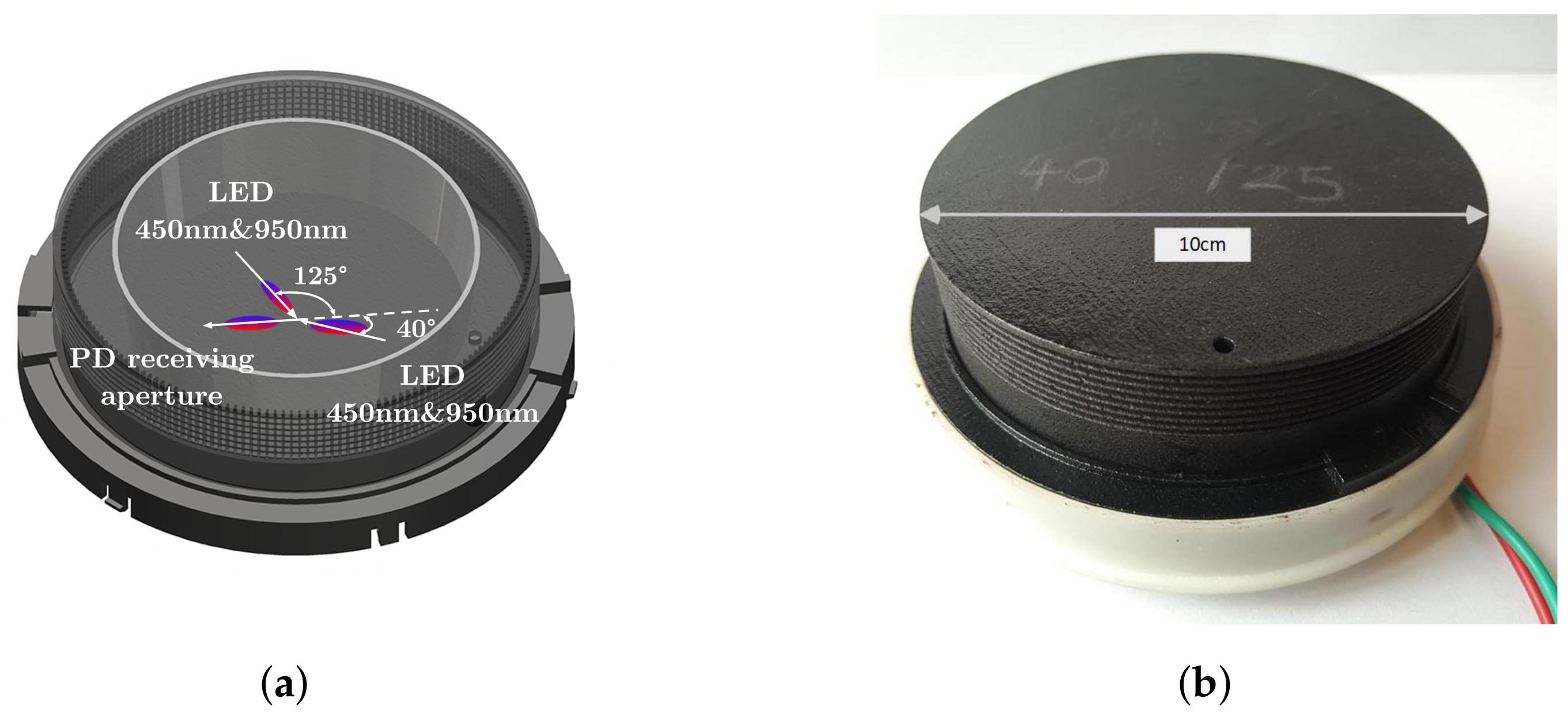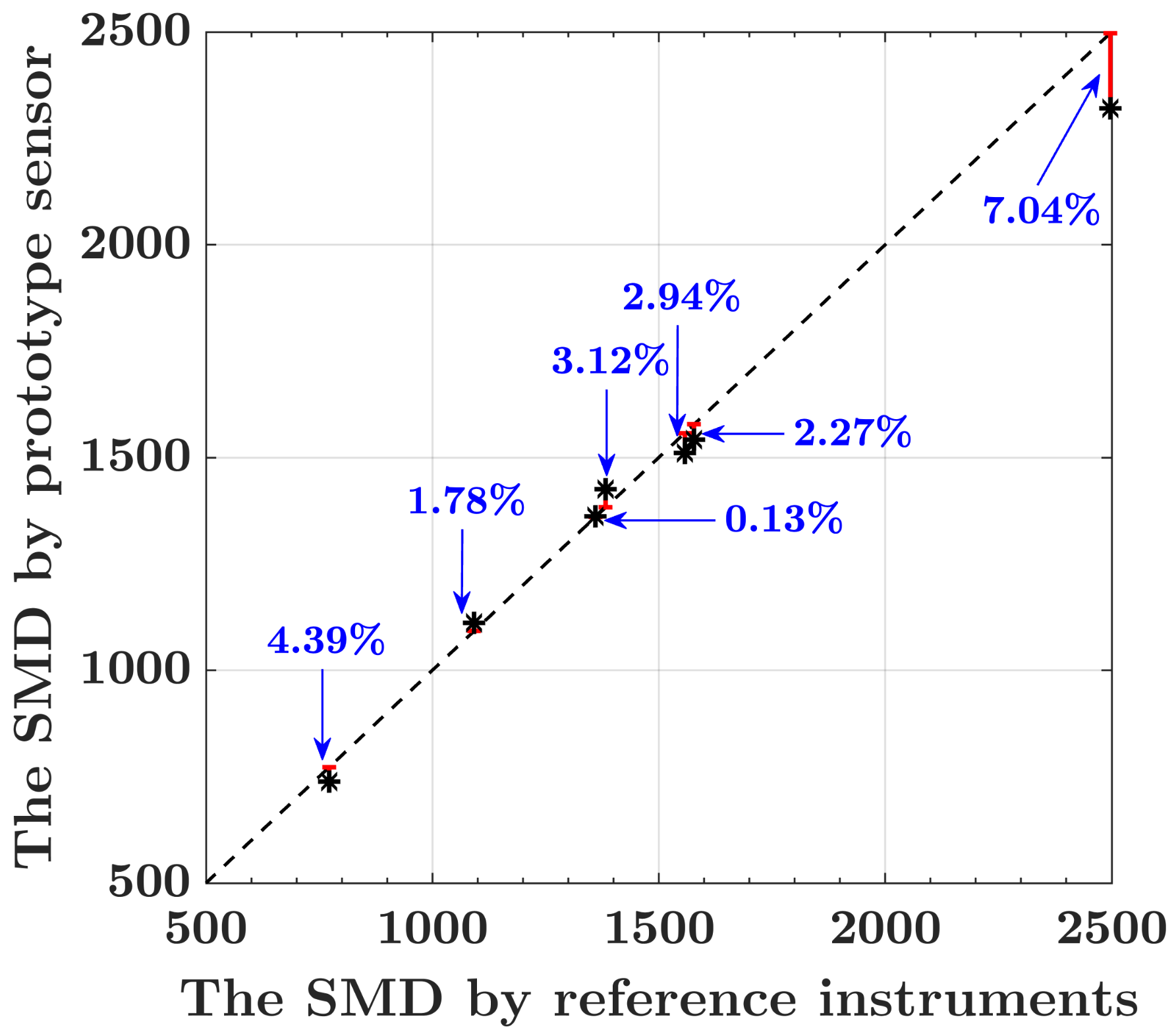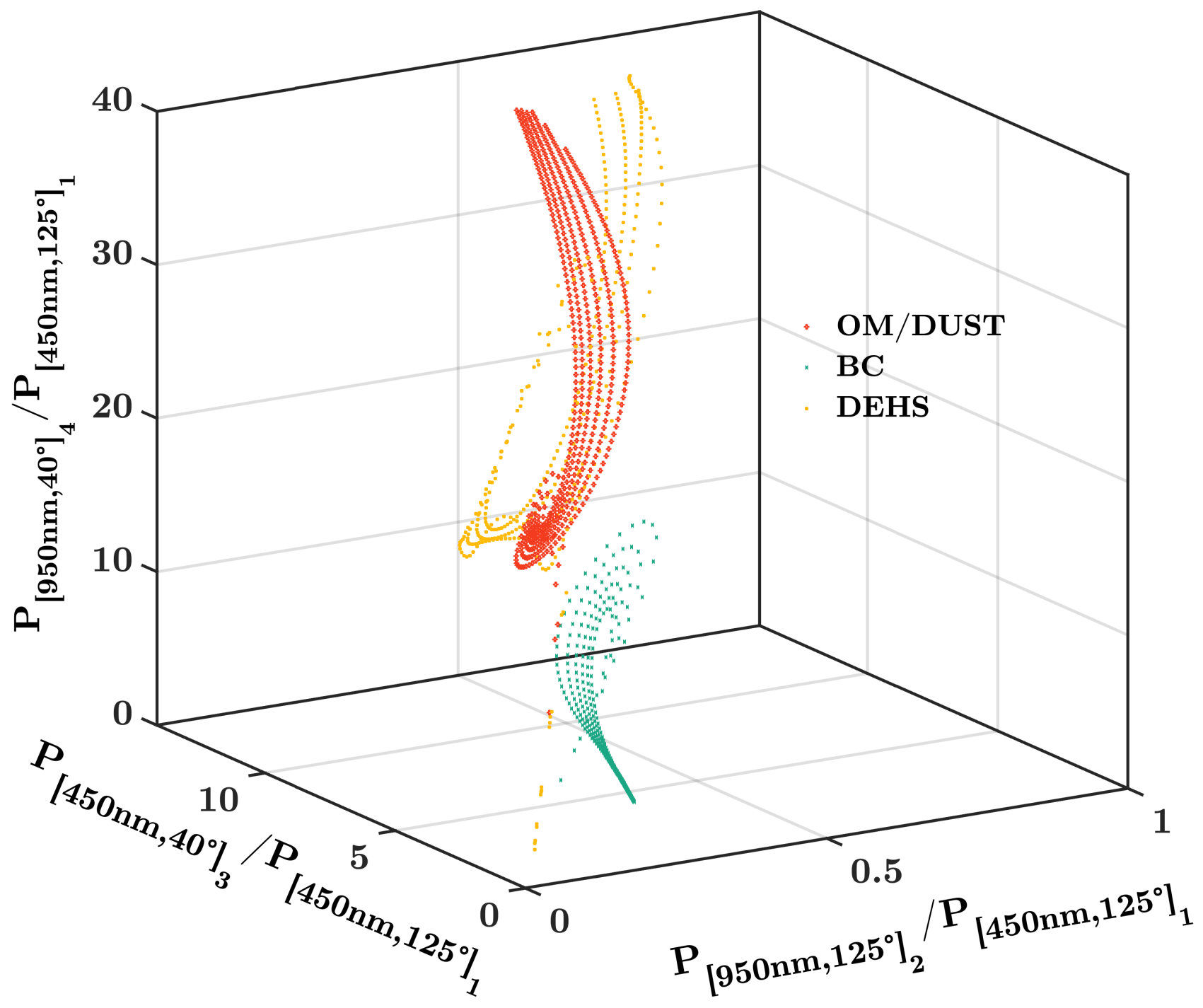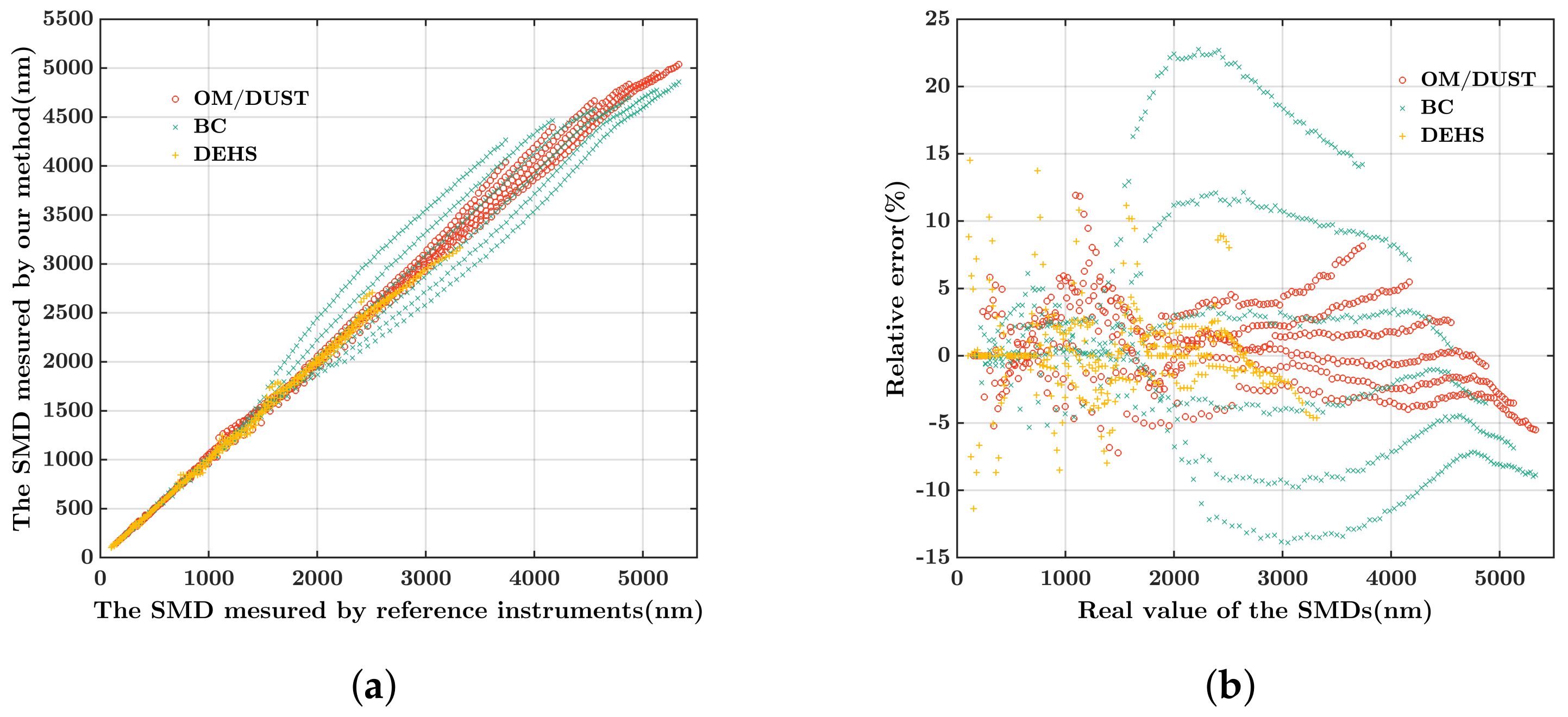A Simple Optical Aerosol Sensing Method of Sauter Mean Diameter for Particulate Matter Monitoring
Abstract
:1. Introduction
- (1)
- Firstly, SMD was proposed for the hazard assessment of PM per unit mass concentration, which comprehensively reflects the aerodynamic deposition distribution, alveolar penetration rate and toxins adsorption in the aspects of both particle size and surface area concentration.
- (2)
- A simple optical sensing method was developed to measure the SMD. A non-linear conversion model is established to precisely calculate the SMD of aerosols with different PSD, while the measurement accuracy of the volume concentration is also improved significantly.
- (3)
- A low-cost and portable proof-of-concept sensor was designed and fabricated by using multiple scattering signals with optimized optical parameters. The simulation and experimental results show that our sensor can precisely measure the SMD and the volume concentration of the aerosol samples.
- (4)
- The sensor is applicable for various PM hazard assessment researches, source attribution investigations, epidemiological studies, and other applications.
2. Materials and Methods
2.1. The Definition of SMD of Particulate Matter
2.2. The Sensing Method of SMD Based on Light Scattering
2.3. The Optimization of Optical Parameters
2.4. The Design of Prototype Sensor
2.5. The Establishment of the Experimental Platform
3. Results and Discussion
4. Conclusions
Author Contributions
Funding
Institutional Review Board Statement
Informed Consent Statement
Data Availability Statement
Acknowledgments
Conflicts of Interest
References
- da Costa e Oliveira, J.R.; Base, L.H.; de Abreu, L.C.; Ferreira Filho, C.; Ferreira, C.; Morawska, L. Ultrafine particles and children’s health: Literature review. Paediatr. Respir. Rev. 2019, 32, 73–81. [Google Scholar]
- WHO. Household Air Pollution and Health. 2019. Available online: https://www.who.int/data/gho/data/themes/air-pollution/household-air-pollution (accessed on 18 March 2022).
- Tasić, V.; Jovašević-Stojanović, M.; Vardoulakis, S.; Milošević, N.; Kovačević, R.; Petrović, J. Comparative assessment of a real-time particle monitor against the reference gravimetric method for PM10 and PM2.5 in indoor air. Atmos. Environ. 2012, 54, 358–364. [Google Scholar] [CrossRef]
- Heal, M.R.; Kumar, P.; Harrison, R.M. Particles, air quality, policy and health. Chem. Soc. Rev. 2012, 41, 6606–6630. [Google Scholar] [CrossRef] [PubMed] [Green Version]
- Schmid, O.; Stoeger, T. Surface area is the biologically most effective dose metric for acute nanoparticle toxicity in the lung. J. Aerosol Sci. 2016, 99, 133–143. [Google Scholar] [CrossRef] [Green Version]
- Lu, Y.; Giuliano, G.; Habre, R. Estimating hourly PM2.5 concentrations at the neighborhood scale using a low-cost air sensor network: A Los Angeles case study. Environ. Res. 2021, 195, 110653. [Google Scholar] [CrossRef] [PubMed]
- Bi, J.; Stowell, J.; Seto, E.Y.; English, P.B.; Al-Hamdan, M.Z.; Kinney, P.L.; Freedman, F.R.; Liu, Y. Contribution of low-cost sensor measurements to the prediction of PM2. 5 levels: A case study in Imperial County, California, USA. Environ. Res. 2020, 180, 108810. [Google Scholar] [CrossRef] [PubMed]
- Liu, X.; Jayaratne, R.; Thai, P.; Kuhn, T.; Zing, I.; Christensen, B.; Lamont, R.; Dunbabin, M.; Zhu, S.; Gao, J.; et al. Low-cost sensors as an alternative for long-term air quality monitoring. Environ. Res. 2020, 185, 109438. [Google Scholar] [CrossRef]
- Schrobenhauser, R.; Strzoda, R.; Fleischer, M.; Hartmann, A.; Amann, M.C. Detection of the mass of fine particulate matter using light scattering and inertial filtering in a miniaturized sensor setup. Meas. Sci. Technol. 2014, 25, 035103. [Google Scholar] [CrossRef]
- Madureira, J.; Slezakova, K.; Costa, C.; Pereira, M.C.; Teixeira, J.P. Assessment of indoor air exposure among newborns and their mothers: Levels and sources of PM10, PM2.5 and ultrafine particles at 65 home environments. Environ. Pollut. 2020, 264, 114746. [Google Scholar] [CrossRef] [PubMed]
- Nishida, R.T.; Johnson, T.J.; Hassim, J.S.; Graves, B.M.; Boies, A.M.; Hochgreb, S. A simple method for measuring fine-to-ultrafine aerosols using bipolar charge equilibrium. ACS Sens. 2020, 5, 447–453. [Google Scholar] [CrossRef] [PubMed]
- Ma, J.; Li, Y.; Liu, Y.; Lin, C.; Cheng, H. Effects of soil particle size on metal bioaccessibility and health risk assessment. Ecotoxicol. Environ. Saf. 2019, 186, 109748. [Google Scholar] [CrossRef] [PubMed]
- Doyi, I.N.; Strezov, V.; Isley, C.F.; Yazdanparast, T.; Taylor, M.P. The relevance of particle size distribution and bioaccessibility on human health risk assessment for trace elements measured in indoor dust. Sci. Total Environ. 2020, 733, 137931. [Google Scholar] [CrossRef] [PubMed]
- Scungio, M.; Rizza, V.; Stabile, L.; Morawska, L.; Buonanno, G. Influence of methodology on the estimation of the particle surface area dose received by a population in all-day activities. Environ. Pollut. 2020, 266, 115209. [Google Scholar] [CrossRef] [PubMed]
- TSI. Aerodynamic Particle Sizer Spectrometer-3321. 2015. Available online: https://tsi.com/products/particle-sizers/particle-size-spectrometers/aerodynamic-particle-sizer-(aps)-spectrometer-3321/ (accessed on 18 March 2022).
- TSI. Scanning Mobility Particle Sizer-3938. 2017. Available online: https://tsi.com/products/particle-sizers/particle-size-spectrometers/scanning-mobility-particle-sizer-spectrometer-3938/ (accessed on 18 March 2022).
- Malvern. Mastersizer 3000 Laser Particle Size Analyzer. 2011. Available online: https://www.malvernpanalytical.com/en/products/product-range/mastersizer-range/mastersizer-3000 (accessed on 18 March 2022).
- TSI. Optical Particle Sizer 3330. 2015. Available online: https://www.tsi.com/optical-particle-sizer-3330/ (accessed on 18 March 2022).
- EcoChem. EcoChem-Diffusion Charger-DC 2200CE. 2014. Available online: https://www.ecochem.biz/Particles/DiffusionCharger.php (accessed on 18 March 2022).
- Kwon, H.B.; Song, W.Y.; Lee, T.H.; Lee, S.S.; Kim, Y.J. Monitoring the effective density of airborne nanoparticles in real time using a microfluidic nanoparticle analysis chip. ACS Sens. 2021, 6, 137–147. [Google Scholar] [CrossRef] [PubMed]
- Greenberg, P.; Fischer, D. Advanced particulate sensors for spacecraft early warning fire detection. In Proceedings of the 40th International Conference on Environmental Systems, Barcelona, Spain, 11–15 July 2010; p. 6243. [Google Scholar]
- Greenberg, P.S.; Fischer, D.G. Detection of spacecraft fire signatures and post-fire aerosols—Part I: Ground-based results. Fire Saf. J. 2015, 75, 36–44. [Google Scholar] [CrossRef]
- Wang, D.; Fan, L.S. Particle characterization and behavior relevant to fluidized bed combustion and gasification systems. In Fluidized Bed Technologies for Near-Zero Emission Combustion and Gasification; Elsevier: Amsterdam, The Netherlands, 2013; pp. 42–76. [Google Scholar]
- Wikipedia. Sauter Mean Diameter. 2021. Available online: https://en.wikipedia.org/wiki/Sauter_mean_diameter (accessed on 18 March 2022).
- Chen, L.; Li, G.; Ma, X.; Lim, J.; Sivathanu, Y. A method for measuring planar Sauter mean diameter of multi-component fuel spray based on the combined statistical extinction tomography and particle imaging velocimetry. Fuel 2018, 214, 154–164. [Google Scholar] [CrossRef]
- Wang, B.; Yang, G.; Tian, H.; Li, X.; Yang, G.; Shi, Y.; Zhou, Z.; Zhang, F.; Zhang, Z. A new model of bubble Sauter mean diameter in fine bubble-dominated columns. Chem. Eng. J. 2020, 393, 124673. [Google Scholar] [CrossRef]
- Chemyakin, E.; Burton, S.; Kolgotin, A.; Müller, D.; Hostetler, C.; Ferrare, R. Retrieval of aerosol parameters from multiwavelength lidar: Investigation of the underlying inverse mathematical problem. Appl. Opt. 2016, 55, 2188–2202. [Google Scholar] [CrossRef] [PubMed] [Green Version]
- Wang, S.; Xiao, X.; Deng, T.; Chen, A.; Zhu, M. A Sauter mean diameter sensor for fire smoke detection. Sens. Actuators B Chem. 2019, 281, 920–932. [Google Scholar] [CrossRef]
- Zhang, Y.; Li, Z.; Sun, Y.; Lv, Y.; Xie, Y. Estimation of atmospheric columnar organic matter (OM) mass concentration from remote sensing measurements of aerosol spectral refractive indices. Atmos. Environ. 2018, 179, 107–117. [Google Scholar] [CrossRef]
- Hulst, H.C.; van de Hulst, H.C. Light Scattering by Small Particles; Courier Corporation: Chelmsford, MA, USA, 1981. [Google Scholar]
- Kulkarni, P.; Baron, P.A.; Willeke, K. Aerosol Measurement: Principles, Techniques, and Applications; John Wiley & Sons: Hoboken, NJ, USA, 2011. [Google Scholar]








| Channel Number j | Incident Light Wave Lengths (nm) | Observing Angle (°) |
|---|---|---|
| 2:1:5 | 4:5:140 |
| Aerosol Type | Particle Size Distribution Range (nm) | Count Median Diameter (nm) | Geometric Standard Deviation | Refractive Index m |
|---|---|---|---|---|
| OM & Dust | 10:10:10,000 | 100:25:2500 | 1.5:0.1:2.0 | |
| BC | 10:10:10,000 | 100:25:2500 | 1.5:0.1:2.0 | |
| DEHS & Dust | 10:10:10,000 | 100:25:2500 | 1.1:0.1:1.4 | 1.45 |
| Channel Number j | 2 | 3 | 4 | 5 |
|---|---|---|---|---|
| RSD | 70% | 9% | 6% | 6% |
| Groups | 1 | 2 | 3 | 4 | 5 | 6 | 7 |
|---|---|---|---|---|---|---|---|
| Reference | 97.20 | 90.70 | 130.00 | 108.00 | 149.00 | 107.00 | 175.00 |
| Single Channel & Relative Error | 162 (66.67%) | 126 (38.92%) | 115 (11.54%) | 105 (2.78%) | 87 (41.61%) | 78 (27.10%) | 93 (46.84%) |
| Prototype Sensor & Relative Error | 81.04 (16.63%) | 96.09 (5.94%) | 123.35 (5.12%) | 123.54 (14.39%) | 113.71 (23.68%) | 110.91 (3.65%) | 212.53 (21.45%) |
Publisher’s Note: MDPI stays neutral with regard to jurisdictional claims in published maps and institutional affiliations. |
© 2022 by the authors. Licensee MDPI, Basel, Switzerland. This article is an open access article distributed under the terms and conditions of the Creative Commons Attribution (CC BY) license (https://creativecommons.org/licenses/by/4.0/).
Share and Cite
Li, L.; Chen, A.; Deng, T.; Zeng, J.; Xu, F.; Yan, S.; Wang, S.; Cheng, W.; Zhu, M.; Xu, W. A Simple Optical Aerosol Sensing Method of Sauter Mean Diameter for Particulate Matter Monitoring. Biosensors 2022, 12, 436. https://doi.org/10.3390/bios12070436
Li L, Chen A, Deng T, Zeng J, Xu F, Yan S, Wang S, Cheng W, Zhu M, Xu W. A Simple Optical Aerosol Sensing Method of Sauter Mean Diameter for Particulate Matter Monitoring. Biosensors. 2022; 12(7):436. https://doi.org/10.3390/bios12070436
Chicago/Turabian StyleLi, Liangbo, Ang Chen, Tian Deng, Jin Zeng, Feifan Xu, Shu Yan, Shu Wang, Wenqing Cheng, Ming Zhu, and Wenbo Xu. 2022. "A Simple Optical Aerosol Sensing Method of Sauter Mean Diameter for Particulate Matter Monitoring" Biosensors 12, no. 7: 436. https://doi.org/10.3390/bios12070436





